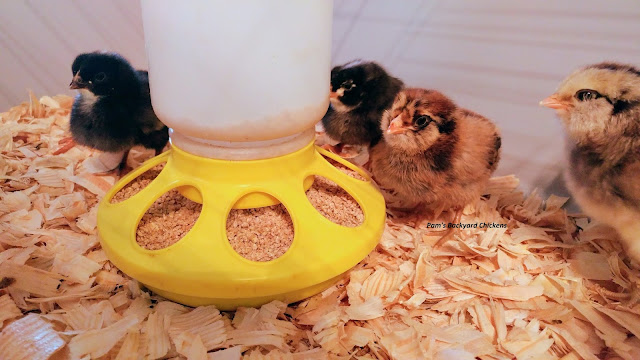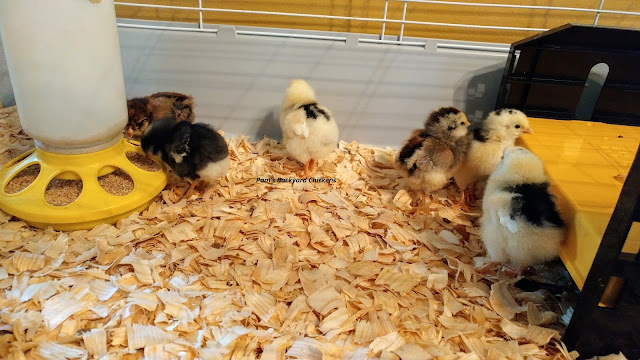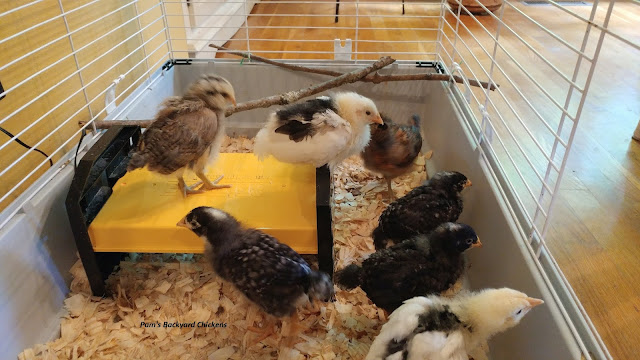Chickens 101 - Can You Have Chickens?
Before getting started raising baby chickens for beginners, be sure to check your local regulations to see if chickens are
allowed in your neighborhood. Most subdivisions with homeowner’s associations don’t
allow it, but some do. Some areas
restrict the number of birds you can keep. Others allow hens but not roosters.
Others regulate how a chicken coop looks, how far from the property line it
must be located etc.
Don’t forget, properly cared for chickens can live a long time.
(I have chickens that are over 10 years old.) They are your responsibility and
are a long-term investment. Don’t purchase because of the pandemic, purchase
because you are ready for the commitment and the reward that comes with it.
Backyard Chicken Lingo
As with every activity in life, there’s usually a set of terms
that defines things. Backyard chicken keeping is no different. In fact, it’s
vital to know the terms of the road before you start out, otherwise, you may end
up where you didn’t want to go.
Hen – A mature female chicken.
Pullet – A female chicken that’s less than a year old.
Rooster (Cock) – A mature male chicken.
Cockerel – A young male chicken.
Straight Run – Unsexed day-old chickens.
Broody Hen – A hen that wants to lay eggs and hatch them.
Clutch – The set of eggs a broody hen sits on to hatch.
Point of Lay – This is the time when pullets begin to lay eggs
for the first time.
Breed – A group of chickens with the same general features of
height, weight, feather color, egg color etc. Examples of breeds are Cochin, Rhode
Island Red, Wyandotte and Orpington. When a breed of chicken mates with its
same breed, you can expect the offspring to have the same characteristics as
the parents. A hybrid chicken is mixed with two or more breeds. Like a mutt., its
offspring will not breed true.
Bantam – A small-sized chicken, usually ¼ to ½ the size of a regular
chicken.
Broiler – A chicken raised for meat.
Laying Hen (Layer) – A chicken raised for its eggs.
Molt – The natural yearly process where chickens shed their
feathers in late summer/early fall and replace them with new feathers. A
chicken’s first adult molt begins around 18 months of age.
Coop and Run – The coop is an enclosed chicken house where
chickens will roost at night and lay their eggs. A run is an enclosed structure
attached to the coop where chickens can get outside and stretch their legs.
Nest Boxes – A designated area of the coop (can be boxes hung
on the coop wall) where hens will lay their eggs. You should provide one nest
box for every four to five hens.
Brooder – This is the area where you hand-raise baby chickens.
It contains a heat source and food and water.
Comb – The fleshy red skin at the top of a chicken’s head.
Wattle – The fleshy red flaps of skin on a chicken’s chin.
Pin the image below to save this information for later.
Day-old chickens will come sexed as pullets or unsexed as
straight run. If you purchase straight run, that means you’re going to get
males and females together. Statistics show straight run is about 50/50 females
to males. If you can’t have roosters or don’t want them, don’t purchase
straight run. Know, however, that sexing day-old chicks is not completely
accurate, so sexed pullets may not all turn out to be hens. In a farm store,
you also can’t be sure a worker or shopper always picks up a chicken and puts
it back in the right brooder. Sometimes straight-run chicks end up in pullet
bins.
Note: You do not need a rooster for a hen to lay eggs, she
will lay eggs regardless of whether you have a rooster. A rooster is only
needed to fertilize eggs.
If you purchase from a farm store, you will be able to handpick your chicks. Be sure you are happy with your choices before you leave the
store as they don’t usually accept returns. Know that many stores have a
minimum number of chicks or ducks, that you must purchase at one time. The
most common minimums are three or six at a time.
Choosing Your Chicken Breed
Breed choice is part of the fun of chicken ownership - there are literally hundreds to
choose from! Here are some categories to consider based on your goals — egg layer,
dual-purpose (can be used for eggs and meat), meat bird, weather tolerance
(heat, cold or both). Within those parameters, there are many choices. Some are
more family-friendly. Some will go broody more than others. All have unique feather
colors. Egg color may also a consideration.
Note: Eggshell color is genetic and does not affect the taste
of an egg. Egg taste is based on a chicken’s diet and the freshness of the egg.
Raising Baby Chickens
When you hand-raise day-old chicks, you are replacing their
broody mom, so you’ve got to provide what she would provide them — shelter,
warmth, food and water.
Don’t spend a lot of money on your brooder because it will
need to get bigger as your chicks get bigger. You don’t want it too big in the
beginning because the chicks shouldn’t get too far from their heat source. Three
examples I have used are a large plastic storage tub, an old guinea pig cage
and a mesh puppy playpen. I raise my chicks inside the house and then move the
brooder to the garage as the chicks get bigger (and messier). Make sure your
brooder is secure on the top because baby chickens can fly!
For heat, there are two popular options, a heat lamp and a
brooder plate. I started out raising baby chickens with a heat lamp. It worked well,
but you’ve got to be careful because a heat lamp can be a fire hazard.
Eventually, I splurged and switched to a brooder plate. I wish I had done it
sooner (a Brinsea EcoGlow, in case you're curious). I wish I had done it sooner. It’s easier, uses less electricity and has
a greatly reduced fire risk. You also don’t have to worry so much about the
temperature. Just make sure the room where your chicks are being raised is a
good temperature. (I keep mine at 73°F.) Then let the chicks do the rest. They
will run out from under the brooder plate to get food and water and to explore,
then run back under when they need some heat. This is what they would do if
they were being raised by mom.
If you’re using a heat lamp, you need to measure the
temperature at the bottom of the brooder since that’s where the chicks hang
out. From hatch to one week of age, the brooder temperature should be 90 to 95°F and then go down five degrees each week. Watch your chicks closely. If
they are cold, they’ll huddle around the heat and will chirp loudly, if they’re
too hot, they’ll be sprawled out around the brooder and pant. Make adjustments
as needed.
Special chick-sized equipment for food and water is available
and helpful. Know that as the chicks grow, you’ll need to raise the food and
water to their height to reduce waste. Until pullets reach their point of lay, they
must be fed starter/grower feed. This comes in two different formulations:
medicated and non-medicated. The medicated feed contains amprolium which keeps
the number of coccidia low in the chick’s system so their maturing immune
system isn’t overwhelmed and they develop coccidiosis which can result in poor
growth and death. If your chicks have been vaccinated for coccidiosis, they
don’t need medicated starter feed.
Note: Do not feed layer feed meant for hens that are already
laying eggs to baby chickens. Layer feed contains calcium which is harmful to a
growing chick. If you have a mixed flock of adults and young chickens, switch
everyone to starter/grower feed and offer calcium free-choice to the adults.
When Can My Chicks Go Outside?
For the first month of life, chicks aren’t fully feathered and
can’t regulate their body temperature. If the chicks are a few weeks old and you
have a warm day, you can take them outside to a protected enclosed area for
short visits, but stay with them and bring them back inside if the weather
turns or they are showing signs of distress.
Your chickens can live outside full time when they are around nine
to 10 weeks of age and the weather is not dipping into the 50s at night.
If you have an existing flock, you should wait
to integrate the new chicks until they are about the same size as the older
birds. This can take a bit and may require temporary separate housing.
When Will I Get Eggs?
The quick answer to when you’ll get eggs is around 18 to 20
weeks of age. This can take longer depending on the breed and the time of year
you purchased your chicks. If you are raising chicks in the fall, they will
mature in the winter and will not lay eggs until the length of daylight
increases. Chickens need about 16 hours of light each day to maintain
consistent egg laying.
Around 18 weeks, introduce layer feed to your hens. This will
give them more calcium to make their eggs. Don’t go cold turkey on the feed.
Make the switch gradually to allow their systems time to adjust.
This is also the time to introduce nest boxes. Line the boxes
with some clean shavings and place a few fake eggs into each box. This shows
the hens where to lay.
As your hens start to lay, be aware their first eggs will be
small and of inconsistent quality. This is the time you may find more
double-yolk eggs. This is all normal as a hen’s body adjusts to the rhythm of
laying.
Collect eggs often and make the decision to wash or not. Eggs
have a protective layer called a cuticle. It’s what you see that’s shiny and
wet when an egg is first laid. It dries quickly and is efficient at keeping out
bacteria. If you wash an egg, the cuticle is removed and the egg should be stored
in the refrigerator. Many backyard chicken keepers don’t wash their eggs unless
they are heavily soiled. Small particles can be brushed or picked off.
Broiler Chickens
Raising chickens for meat is possible and not terribly time-consuming. First, decide how much meat you’ll need for your family for a period
of time, say six months or a year. That’s how many birds you should raise,
process and freeze. (Maybe throw in an extra bird or two in case of losses.) Then,
decide what you want to raise.
There are a couple ways you can go with meat birds — raise
hybrids specifically designed for meat or raise dual-purpose breeds.
With the hybrid birds, there are usually two offerings, a
Cornish Cross-type or a Ranger type.
The Cornish Cross is a white bird meant for confinement. It
grows quickly and is ready to process around eight weeks for a five-pound table
bird. (It takes about 10 pounds of feed per bird to reach this weight.) If you
want a larger table bird, you can let them go a bit longer, but don’t wait too
long. Because of their robust growth, Cornish Cross can develop
life-threatening health problems and suffer.
Note: Broilers can overheat easily because of their rapid
weight gain. It’s best to raise them early or late in the season to take
advantage of cooler weather.
Ranger birds can free-range and take a bit longer until
processing time around nine to 12 weeks of age.
If you’re raising dual-purpose birds, you can pick straight
run and eat the roosters leaving the hens for egg production. Dual-purpose
birds can be processed around 16 weeks.
Both the rangers and dual-purpose birds are said to have more
flavorful meat with little fat because they can free-range and have a more
natural diet.
Keep in mind the difference between the live weight and the edible portion of a chicken is roughly 70 percent give or take a little for
breed.
Broilers should be raised on starter/grower feed for three to
four weeks and then switched to grower/finisher feed.
If you are not prepared to slaughter your own birds, look to
local sources. There are usually processors that handle 4-H birds and can
process your birds too. You usually need to set up the processing date when you
first get your birds, that way the processor can fit you in the schedule.
Ongoing Maintenance
On a daily basis, chickens are easy to maintain. At a minimum,
they should be let out of their coop to roam their enclosed run or safely free
range in the morning. They need fresh water and food each day and refreshed as
needed. Their eggs should be collected each day and they should be closed safely
in their coop at dusk.
Cleanliness is key to good health. The coop bedding (pine
shavings are my preference) should be changed as needed. If your birds free
range during the day, the bedding won’t get dirty as fast as the bedding for
confined chickens.
Your birds can help you turn kitchen waste into eggs/meat as
you feed them your leftover scraps. Just make sure not to make treats,
including scratch grains, too much of their diet. A ratio of 90 percent formulated
diet to 10 percent treats is a good gauge.
All said, raising backyard chickens provides
your family with a reliable source of food and it can be a wonderful learning
experience for children. Plus, who doesn't love an adorable baby chicken?
As seen in The New Pioneer magazine.



.jpg)




No comments:
Post a Comment